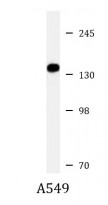ARG58599
anti-EphA1 antibody
anti-EphA1 antibody for Western blot and Human
Overview
| Product Description | Rabbit Polyclonal antibody recognizes EphA1 |
|---|---|
| Tested Reactivity | Hu |
| Tested Application | WB |
| Host | Rabbit |
| Clonality | Polyclonal |
| Isotype | IgG |
| Target Name | EphA1 |
| Antigen Species | Mouse |
| Immunogen | KLH-conjugated synthetic peptide between aa. 453-487 of Mouse EphA1. |
| Conjugation | Un-conjugated |
| Alternate Names | EPH tyrosine kinase; EPH tyrosine kinase 1; Tyrosine-protein kinase receptor EPH; EPHT; Ephrin type-A receptor 1; hEpha1; EPH; Erythropoietin-producing hepatoma receptor; EC 2.7.10.1; EPHT1 |
Application Instructions
| Application Suggestion |
|
||||
|---|---|---|---|---|---|
| Application Note | * The dilutions indicate recommended starting dilutions and the optimal dilutions or concentrations should be determined by the scientist. | ||||
| Positive Control | A549 |
Properties
| Form | Liquid |
|---|---|
| Purification | Purification with Protein A and immunogen peptide. |
| Buffer | PBS and 0.09% (W/V) Sodium azide. |
| Preservative | 0.09% (W/V) Sodium azide |
| Storage Instruction | For continuous use, store undiluted antibody at 2-8°C for up to a week. For long-term storage, aliquot and store at -20°C or below. Storage in frost free freezers is not recommended. Avoid repeated freeze/thaw cycles. Suggest spin the vial prior to opening. The antibody solution should be gently mixed before use. |
| Note | For laboratory research only, not for drug, diagnostic or other use. |
Bioinformation
| Database Links | |
|---|---|
| Gene Symbol | EPHA1 |
| Gene Full Name | EPH receptor A1 |
| Background | This gene belongs to the ephrin receptor subfamily of the protein-tyrosine kinase family. EPH and EPH-related receptors have been implicated in mediating developmental events, particularly in the nervous system. Receptors in the EPH subfamily typically have a single kinase domain and an extracellular region containing a Cys-rich domain and 2 fibronectin type III repeats. The ephrin receptors are divided into 2 groups based on the similarity of their extracellular domain sequences and their affinities for binding ephrin-A and ephrin-B ligands. This gene is expressed in some human cancer cell lines and has been implicated in carcinogenesis. [provided by RefSeq, Jul 2008] |
| Function | Receptor tyrosine kinase which binds promiscuously membrane-bound ephrin-A family ligands residing on adjacent cells, leading to contact-dependent bidirectional signaling into neighboring cells. The signaling pathway downstream of the receptor is referred to as forward signaling while the signaling pathway downstream of the ephrin ligand is referred to as reverse signaling. Binds with a low affinity EFNA3 and EFNA4 and with a high affinity to EFNA1 which most probably constitutes its cognate/functional ligand. Upon activation by EFNA1 induces cell attachment to the extracellular matrix inhibiting cell spreading and motility through regulation of ILK and downstream RHOA and RAC. Plays also a role in angiogenesis and regulates cell proliferation. May play a role in apoptosis. [UniProt] |
| Calculated MW | 108 kDa |
| PTM | Phosphorylated. Autophosphorylation is stimulated by its ligand EFNA1. Ubiquitinated. [UniProt] |
Images (1) Click the Picture to Zoom In






